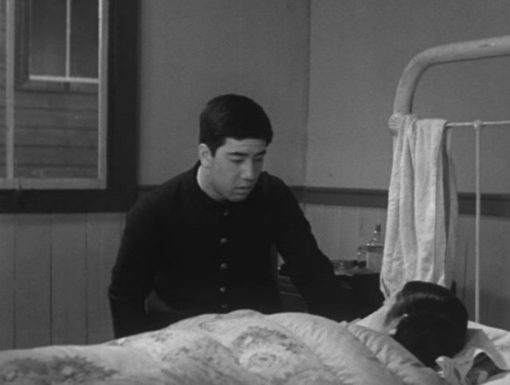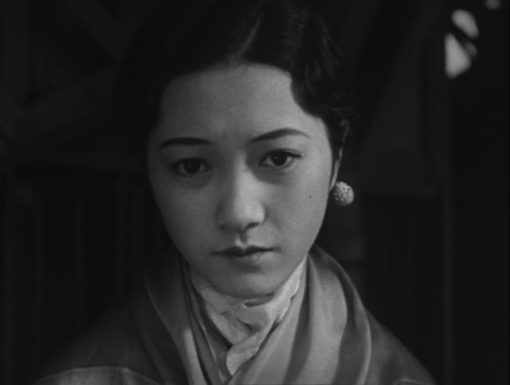Despite some critical success, Mikio Naruse was in a tough position by 1933. His peers admired his work but his studio boss, Shiro Kido, was unimpressed. We now know that the friction between these two lead to Naruse’s transfer to PCL, which later become Toho. However, in 1933, the pressure was on for him to deliver a film that doesn’t immediately echo Yasujiro Ozu’s work. Kido would remain skeptical of him, but it is hard to watch a film like Apart From You, and think that it owes any particular debt to Ozu. They do overlap in that they capture the reconfiguration of rural spaces, which would be transformed to suburbs. Ozu (literally) moved up within Tokyo to more middle class families. Naruse moved outward to the margins that so many of his characters had already called home.
Kikue is an aging geisha struggling to keep her most devoted client interested. Her son, Yoshio, contributes to this frustration by his truancy at school. He’s fallen into a young gang, and when asked about his disobedience, he lashes out at Kikue and says that he’s embarrassed by her profession. Kikue’s best friend, Terukiku, is also a geisha and around the same age as Yoshio. She tries to convince him that his mother is indeed very devoted to him, and that his agitation with her is misplaced. Terukiku invites Yoshio to join her on a visit to her hometown, which appears idyllic, but is revealed to be a site of abuse and anger. Seeing the familial discord has an impact on Yoshio, but he’s not quite prepared to straighten up immediately on the trip back.
My earlier review of this film, published in 2008, is pretty generic. I don’t want to turn this into a complete overview of my writing at the time, but while it is not a particularly offensive piece, it is not a very interesting one either. Apart From You is at its heart, a melodramatic film. One that seems to be missing the necessary dramatic syntax to make such a film work. It’s only an hour long, and so there’s little time to capture the anxiety rising up on Kikue, Terukiku, and Yoshio. While I still love this film, it might be for completely new reasons now. Perhaps it is an unintentional side effect, but Naruse’s camera does capture the liminal part of Tokyo’s transition. Other filmmakers situated their “urban dramas” in sexier, more fully developed spaces. But, in fitting with the economic plight of his characters, Naruse captures a neighborhood that still has rural residue. The trip to Terukiku’s home town sets up a narrative contrast, between the city and country, but Naruse’s camera suggests that describe the spaces in such a binary is incorrect.
Terukiku’s hometown remains unnamed, but we do now that she and Yoshio are able to easily access it via railroad. One might deduce that it is a present-day suburb, transitioning from its rural past, not unlike the suburb occupied by the family in I Was Born But… There is plenty of visual evidence to describe the space as “less sophisticated” but Suketaro Inokai’s camera captures a richness in the street life. Less developed and less commercial than the Tokyo the film opens with, but not reduced to the condescendingly rural. The two primary spaces of the film can’t be positioned as a binary, which works with Naruse’s handling of the characters. The plot could be described as trite, but the dramatization of their emotions is complicated. In fact, words seem especially inefficient to describe the film’s finale.
Terukiku and Yoshio return to Tokyo, where Kikue contemplates suicide. In one particularly impressive sequence, Kikue’s violent confrontation with her patron is paired next to a more jovial encounter between younger geishas with younger patrons. Kikue is, in the end, saved but violence is unrelenting here. Yoshio’s attempt to quit his gang leads to ridicule, which then ends with Terukiku being injured. The film’s conclusion is unclear, but we know that Terukiku, because of her selfish father’s economic wants, must leave Tokyo for a profession even less desirable than that of a geisha. Sex, of course, is not explicit in a film from 1933 Japan, but Terukiku is presumably shipped off to a brothel. I would suggest that Naruse’s entire career shows compassion to sex workers, as opposed to the anxiety evident in other such films. Terukiku and Yoshio’s farewells to each other are bittersweet but she’s already told us that “she’ll keep fighting.” The film ends with her departing, potentially, for a life of more abuse. Visually, we understand that hope is still there. For others, this would be the conclusion to the tragedy, but Naruse is more pragmatic. Terukiku leaves the frame, but her agency feels firmly intact.




